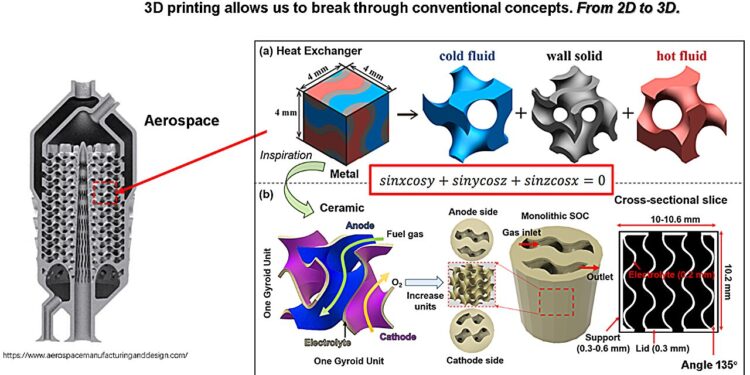Image summarizing the inspiration behind the document, which aims to introduce a gyroid heat exchanger, in particular for aerospace applications. Credit: K. Yan, H. Deng, Y. Xiao, J. Wang, Y. Luo, Assessment of thermo-hydraulic performance by experience and simulation of the heat exchanger with additive gyroid structure, thermal applied Engineering 241 (2024) 122402.
In recent decades, energy engineers have developed a wide range of new technologies that could supply electronic devices, robots and electric vehicles more efficiently. These include solid oxide cells (SOC), electrochemical devices that can operate in two different modes, as fuel cells or as electrolysis.
Fuel batteries are devices that can convert energy into specific chemicals into electricity via chemical reactions. Electrolysers, on the other hand, are technologies that can divide water (h2O) or other molecules using electricity, to produce hydrogen (h2) or other desirable chemicals.
Until now, most of the developed SOCs have been two -dimensional (2D) and consist of flat structures with stricken layers of different materials. This 2D design, however, limits the extent to which the devices can be reduced in size while increasing their weight, because it relies on metal interconnections to allow different components energy and seal.
Researchers from the Denmark Technical University have recently designed new three -dimensional (3D) Soc with a periodic surface structure known as the Gyroid. These cells, described in an article published in Nature energyCan be made using 3D printing, also known as the additive manufacturing.
“It has been shown that the use of gyroid structures in heat exchangers reduces weight, improves compactness and increases efficiency,” Tech Xplore, Professor Vincenzo Esposito, corresponding author of the newspaper. “We replace metal with an ion conductive ceramic, thus making the 3D-Soc concept. 3D-SOC is well suited for applications that require light construction, compactness and stability, such as those of aerospace and automobile industries.”
Image showing the structure and components of conventional Soc batteries, including unique cells, metal interconnections and seals. Credit: (December 24, 2023).
The monolithic gyrodial soc developed by Professor Esposito and his colleagues have three main components: a dense ceramic electrolyte, a porous fuel electrode and a porous oxygen electrode. Like other SOCs, they can work in two different modes, namely fuel batteries or electrolysers.
“In fuel cell mode (SOFC), the cell generates electricity using fuel gas such as H₂, CH₄ and CO, normally called X for food,” said Professor Esposito. “In electrolysis mode (SOEC), it produces fuel gases and O₂ by electrolyzing H₂o or Co₂, called power to X.”
To make their 3D SoC, the researchers first carried out their monolithic ceramic frame, which includes an electrolyte, the sealing and support structure. This whole structure was made using 3D printing technology.
Thereafter, they coated the fuel electrode and the oxygen electrode on the surfaces of the electrolyte. Finally, they co-spinned the electrolyte, the fuel electrode and the oxygen electrode, ultimately reaching a functional monolithic gyroid sock.
“Compared to the conventional SOC battery technology, 3D-Soc has an extremely simplified manufacturing process,” said Dr. Zhipeng Zhou, principal author of the newspaper. “A battery of conventional SOC requires the integration of many components, including unique cells, metal interconnections and seals. On the other hand, 3D SoC can be manufactured using only processes of printing, coating and 3D Indication.”
Structural characterization of 3D SOC. Credit: Nature energy (2025). DOI: 10.1038 / S41560-025-01811-Y
Unlike 2D SOCs, the 3D system developed by researchers can be set up without the need for additional components, which reduces its overall weight. In addition, the new team design allows a larger space for electrolyte, while minimizing the size of the cell and maximizing its compactness.
“The 3D-Soc is flexible and could be put on the scale without metallic interconnections,” said Dr. Zhou. “The complete elimination of metal interconnections has considerably improved the stability of the SOC system and reduces its cost.”
The recent work by Professor Esposito, Dr. Zhou and their colleagues are opening new exciting possibilities for the manufacture of 3D SOC. In the future, the devices they have designed could be improved more and deployed in various contexts, especially in the aerospace and automotive industries.
“Some examples include the NASA Mars program and Airbus SOFC planes (Hylena | Airbus),” said Dr. Venkata Nadimpalli, corresponding author of the newspaper. “From a scientific perspective, 3D-SOC has fundamentally different structures compared to conventional SOC conceptions. Consequently, the conclusions drawn from traditional SOCs may not apply to 3D SOCs, due to their distinct gas distribution and their heat transport properties.”
Professor Esposito, Dr. Zhou and Dr. Nadimpalli hope that their study will soon inspire other research groups to design similar 3D SOCs, very efficient and more scalable.
Written for you by our author Ingrid Fadelli, edited by Gaby Clark, and verified and examined by Robert Egan – This article is the result of meticulous human work. We are counting on readers like you to keep independent scientific journalism alive. If this report matters to you, please consider a donation (especially monthly). You will get a without advertising count as a thank you.
More information:
Zhipeng Zhou et al, monolithic cells with solid gyroid oxide by additive manufacturing, Nature energy (2025). DOI: 10.1038 / S41560-025-01811-Y.
© 2025 Science X Network
Quote: Solid oxide cells gyroidal printed in 3D offer lighter and more compact energy solutions (2025, August 20) recovered on August 20, 2025 from
This document is subject to copyright. In addition to any fair program for private or research purposes, no part can be reproduced without written authorization. The content is provided only for information purposes.



